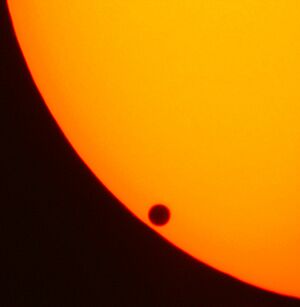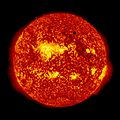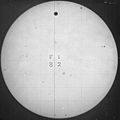Transit of Venus facts for kids
A transit of Venus happens when the planet Venus passes directly between the Sun and Earth. Imagine Venus as a tiny black dot moving across the bright face of the Sun. This event is a type of occultation, where one celestial body blocks another. A transit of Venus can last for several hours.
These transits are very rare events in astronomy. They follow a special pattern that repeats every 243 years. Transits usually happen in pairs, with eight years between them. Then there are long waits of 121.5 years and 105.5 years before the next pair.
The most recent transit of Venus took place on June 5 and 6, 2012. This was the last one we will see in this century. The one before that was on June 8, 2004. The next transits of Venus will not happen until December 2117 and December 2125. Many people watched the 2012 transit live online.
Contents
Why Transits of Venus Matter
Measuring Space: The Astronomical Unit
In the 1700s, astronomers used transits of Venus to figure out the exact distance from Earth to the Sun. This distance is called the astronomical unit. Knowing this measurement was very important for understanding our solar system.
To do this, scientists needed to watch the transit from many different places on Earth. By comparing their observations, they could use something called parallax. Parallax is how an object seems to shift when you look at it from different angles.
Famous Expeditions to Observe Transits
Many countries sent special trips to far-off lands to see these transits. One of the most famous journeys was made by Lieutenant James Cook. He sailed on the ship HMS Endeavour to observe the 1769 transit from Tahiti. These expeditions were challenging and dangerous, but they helped scientists learn a lot about space.
Images for kids
-
"Venus Tablet of Ammisaduqa", a cuneiform clay tablet of astrological forecasts from the Neo-Assyrian period
-
Jeremiah Horrocks makes the first observation of the transit of Venus in 1639, as imagined by the artist W. R. Lavender in 1903
-
Diagram from Edmund Halley's 1716 paper to the Royal Society showing how the Venus transit could be used to calculate the distance between the Earth and the Sun
-
Diagram from David Rittenhouse's observations of the 1769 transit of Venus
-
The 1882 transit of Venus
-
Transit of Venus from Degania A, Israel, 2004
See also
 In Spanish: Tránsito de Venus para niños
In Spanish: Tránsito de Venus para niños














